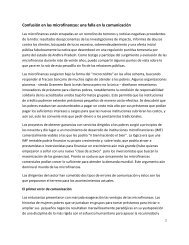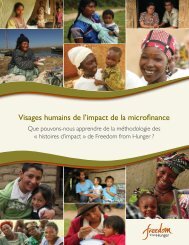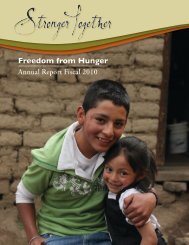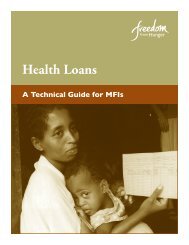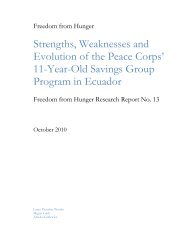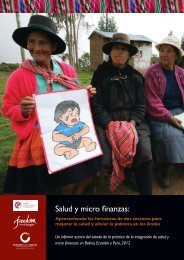history of meals for millions, soy, and freedom from ... - SoyInfo Center
history of meals for millions, soy, and freedom from ... - SoyInfo Center
history of meals for millions, soy, and freedom from ... - SoyInfo Center
You also want an ePaper? Increase the reach of your titles
YUMPU automatically turns print PDFs into web optimized ePapers that Google loves.
also found itself in danger <strong>of</strong> collapsing because <strong>of</strong> a lack <strong>of</strong><br />
money.<br />
“At this critical juncture, Mr. Clinton held a meeting at<br />
his home. Among those present was Florence Rose, who<br />
had accepted an invitation to come to Los Angeles <strong>and</strong><br />
observe the work <strong>of</strong> the infant organization. Here Mr.<br />
Clinton announced that he would no longer be able to<br />
devote as much time to the promotion <strong>of</strong> MPF as he had in<br />
the past <strong>and</strong> asked if anyone present would take over the<br />
direction <strong>of</strong> MFM. When no one else responded, Miss Rose<br />
said she would accept the responsibility because she ‘hated<br />
to see <strong>and</strong> idea die.’<br />
“Mr. Clinton immediately appointed Miss Rose to the<br />
post <strong>of</strong> Executive Secretary <strong>and</strong> named Ernest<br />
Chamberlain,... Secretary... Mr. Clinton’s son, Edmond J.<br />
Clinton, was appointed Vice President. Dr. Borsook<br />
accepted the post <strong>of</strong> Research Director, <strong>and</strong> A.J. Gock, an<br />
<strong>of</strong>ficer <strong>of</strong> the Bank <strong>of</strong> America, agreed to serve as<br />
Treasurer” (p. 17-18).<br />
Biographies are then given <strong>of</strong> Florence Rose <strong>and</strong> Ernest<br />
Chamberlain. “Florence Rose brought to Meals <strong>for</strong> Millions<br />
the knowledge <strong>and</strong> experience <strong>of</strong> a person who had worked<br />
<strong>for</strong> nearly twenty-five years <strong>for</strong> causes espoused by nonpr<strong>of</strong>it<br />
organizations. She had worked in the New York City<br />
<strong>of</strong>fice <strong>of</strong> Margaret Sanger as her personal assistant. “In this<br />
capacity, Miss Rose accompanied her employer on many<br />
trips abroad to promote the idea <strong>and</strong> teach the techniques <strong>of</strong><br />
birth control. Be<strong>for</strong>e she left Margaret Sanger in 1940 to<br />
work <strong>for</strong> Pearl S. Buck, Florence Rose learned to endure the<br />
disappointments that arise out <strong>of</strong> the promotion <strong>of</strong><br />
unpopular causes <strong>and</strong> developed the capacity to persevere in<br />
the face <strong>of</strong> seemingly immovable opposition or apathy.” She<br />
believed in demonstration clinics as used by Mrs. Sanger.<br />
“From personal observation it can also be stated that Miss<br />
Rose possesses an extraordinary amount <strong>of</strong> energy <strong>and</strong> has,<br />
as reflected in her choice <strong>of</strong> career, a keen desire to improve<br />
the lot <strong>of</strong> mankind” (p. 18-19).<br />
Ernest Chamberlain was “a <strong>for</strong>mer lawyer, newspaper<br />
reporter, <strong>and</strong> public relations agent.” Born in Topeka,<br />
Kansas on 18 Aug. 1892, he attended George Washington<br />
University (Washington, DC) where he received a law<br />
degree in 1918. He enlisted in the U.S. Army during World<br />
War I. After the war he worked “in the <strong>of</strong>fice <strong>of</strong> the<br />
Governor <strong>of</strong> Kansas, George Allen, where he became so<br />
fascinated with the socialist doctrines <strong>of</strong> Mr. Jake Sheppard,<br />
an opponent <strong>of</strong> Governor Allen <strong>and</strong> the President <strong>of</strong> the<br />
‘Peoples’ College,’ that he quit his job to teach at the<br />
Peoples’ College <strong>and</strong> to organize Consumers’ stores. A year<br />
later, in 1920, Mr. Chamberlain went to Oklahoma City<br />
where he practiced law primarily in the area <strong>of</strong> civil liberties<br />
<strong>and</strong> worked <strong>for</strong> the Oklahoma Leader, a labor-socialist daily<br />
newspaper. Be<strong>for</strong>e the end <strong>of</strong> 1920 he gave up his law<br />
practice to become a full-time reporter <strong>for</strong> the Oklahoma<br />
Leader,... <strong>and</strong> other publications printed by the Leader<br />
MEALS FOR MILLIONS, SOY, AND FREEDOM FROM HUNGER 83<br />
© Copyright Soyinfo <strong>Center</strong> 2011<br />
Press.” He “also participated in the <strong>for</strong>mation <strong>of</strong> the Farmer-<br />
Labor Reconstruction League, which helped to elect Mr.<br />
Jack Walston governor <strong>of</strong> Oklahoma in 1922 <strong>and</strong> to<br />
impeach him a year later.”<br />
“In the summer <strong>of</strong> 1938, Mr. Chamberlain moved with<br />
his wife <strong>and</strong> two children to Los Angeles where he worked<br />
<strong>for</strong> the in<strong>for</strong>mation <strong>of</strong>fice <strong>of</strong> the WPA. Be<strong>for</strong>e long,<br />
however, his penchant <strong>for</strong> causes asserted itself <strong>and</strong> he<br />
became the press agent <strong>for</strong> Clif<strong>for</strong>d Clinton’s campaign to<br />
remove ten councilmen <strong>from</strong> <strong>of</strong>fice <strong>and</strong> re<strong>for</strong>m the<br />
government <strong>of</strong> the city <strong>of</strong> Los Angeles. By 1942, Mr.<br />
Chamberlain had resigned <strong>from</strong>... WPA <strong>and</strong> was working as<br />
an aide to Mr. Clinton on a full-time basis. Not surprisingly,<br />
given his more than 25 year commitment to helping<br />
underprivileged people, Mr. Chamberlain saw in MPF a<br />
tremendous potential <strong>for</strong> combatting hunger <strong>and</strong> quickly<br />
accepted his employer’s suggestion that he become the<br />
Secretary <strong>of</strong> Meals <strong>for</strong> Millions. MFM thus acquired a man<br />
talented in publicity techniques, familiar with lobbying in<br />
Washington, D.C., <strong>and</strong> obviously ready to devote himself to<br />
a non-pr<strong>of</strong>it cause (p. 20-21).<br />
The final member <strong>of</strong> the trio is Dr. Henry Borsook.<br />
“Holder <strong>of</strong> both a Ph.D. <strong>and</strong> an M.D., Dr. Borsook joined<br />
the staff <strong>of</strong> the Cali<strong>for</strong>nia Institute <strong>of</strong> Technology in 1929”<br />
(p. 21).<br />
MFM was a foundation with no endowment, <strong>and</strong> it was<br />
founded by default. “But the belief in the efficacy <strong>of</strong> action<br />
shared by the three participants in re<strong>for</strong>m movements...<br />
coupled with Dr. Borsook’s <strong>and</strong> their desire to alleviate<br />
human suffering gave MFM the unity <strong>and</strong> strength it needed<br />
to persist in the promotion <strong>for</strong> twenty years” [1946-1966]<br />
(p. 22-23). Continued. Address: Seattle, Washington.<br />
203. Roberts, Hibbert Rice. 1967. The Meals <strong>for</strong> Millions<br />
Foundation: a study <strong>of</strong> a non-governmental organization<br />
(Continued–Document Part III). PhD thesis in Political<br />
Science, University <strong>of</strong> Washington. 288 leaves. [53 + 100+<br />
footnotes]<br />
• Summary: Continued: Chapter 3. “This chapter, which<br />
discusses the <strong>for</strong>mal rules governing the Meals <strong>for</strong> Millions<br />
Foundation <strong>and</strong> the organization, functions, <strong>and</strong> staff <strong>of</strong> its<br />
headquarters in Los Angeles, Cali<strong>for</strong>nia, sets <strong>for</strong>th the<br />
framework intended to support a global ef<strong>for</strong>t against<br />
starvation.” Begins with an analysis <strong>of</strong> the two occasions<br />
when the by-laws <strong>of</strong> the Foundation were revised, <strong>and</strong> the<br />
events which led to these revisions–in 1955 <strong>and</strong> 1962. The<br />
first revision in 1955 (<strong>of</strong> the original 1946 by-laws)<br />
represented an attempt by the board to meet charges “that<br />
the Foundation’s policy-making procedures placed too<br />
much control in the h<strong>and</strong>s <strong>of</strong> a few individuals; the second<br />
in 1962 grew out <strong>of</strong> similar complaints by individuals more<br />
intimately involved in the affairs <strong>of</strong> MFM.” There was a<br />
growing conviction “that it would be advantageous to<br />
involve MFM’s directors more closely in the affairs <strong>of</strong> their



